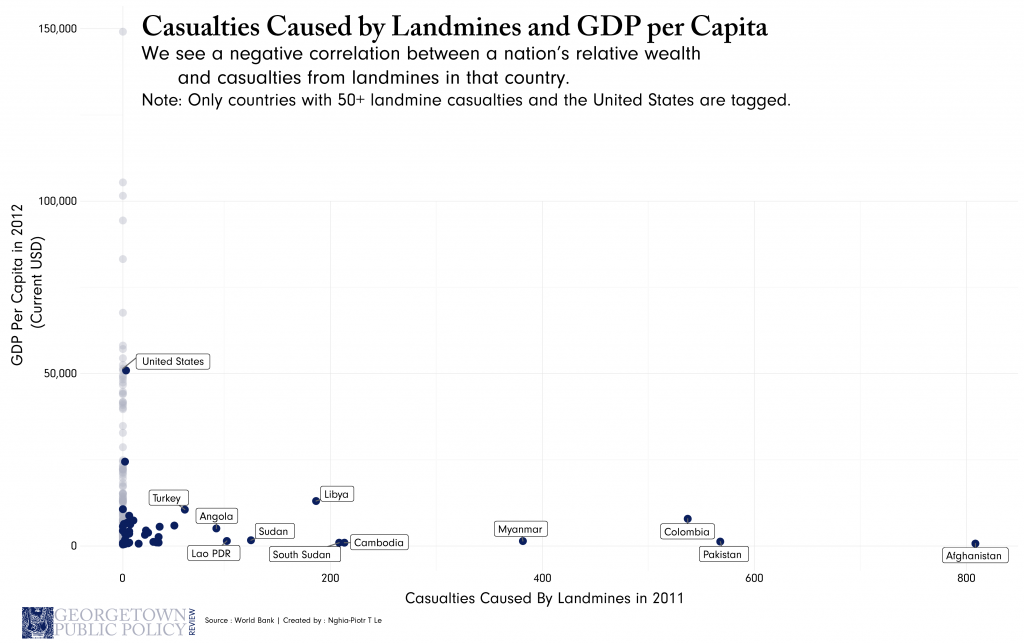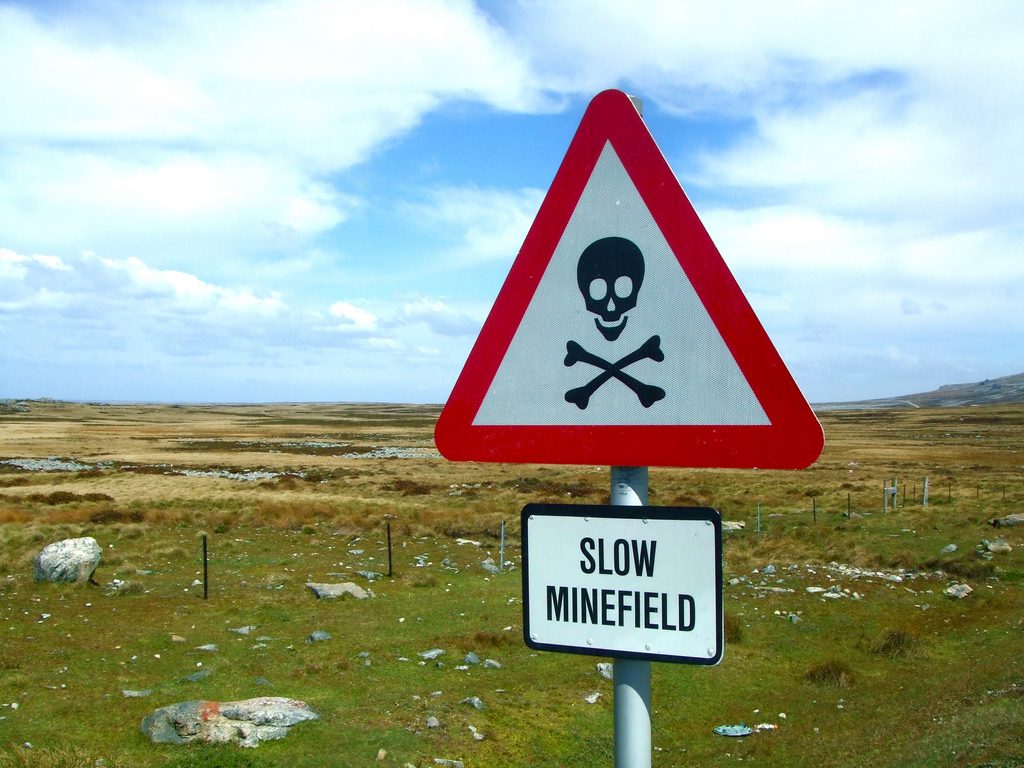Landmines were called ‘perfect soldiers,’ quietly, patiently waiting for their target as long as necessary and highly inexpensive to produce or acquire. For these reasons, landmines or anti-personnel (AP) mines have been the weapon of choice for standing armies and guerilla forces alike in conflicts spanning the last one hundred years, from World War II to the first Gulf War. As the human toll exacted by these indiscriminate devices has become more widely accepted in the international community, new norms of behavior have developed against their use, production, and sale. While the majority of countries in the world have pledged to disavow these weapons, there are several notable exceptions where the use of landmines in war and against civilians continues unabated.
After nearly 60 years of almost continuous conflict, Myanmar is one of the most landmine invested countries in the world. The government is not signatory to the 1997 Mine Ban Treaty, and multiple efforts to locate and remove hidden mines have yet to materialize, resulting in almost no mines being cleared in the last five years. While the 2016 elections show that developments in Myanmar may be changing for the better, landmines still pose an existential threat to nearly five million people living in the country. Furthermore, the country’s population is in flux as current armed conflicts in Myanmar continue to displace civilians. With initiatives to repatriate refugees living in Thailand moving forward, hundreds of thousands more people could be moved to landmine infested lands.
Landmines and International Human Rights
The 1997 Mine Ban Treaty – formally the Convention on the Prohibition of the Use, Stockpiling, and Transfer of Anti-Personnel Mines and their Destruction – was enacted on March 1, 1999 and has currently been adopted by over three quarters of the world’s countries.[1] As of 2016 162 countries have signed the Treaty, and Sri Lanka is reportedly to soon be the 163rd. The convention is not just successful on paper, but has accomplished tangible results. According to reports, the number of landmine victims worldwide has decreased every year since the Treaty’s enactment and millions of landmines have since been destroyed.
The moral impetus for this treaty is clear – because landmines cannot distinguish from combatant and civilian, they present a grave challenge to humanitarian ideals and international human rights norms. Furthermore, in many cases landmines disproportionately impact already marginalized and disenfranchised groups, such as displaced people and ethnic and religious minorities. Landmines also have a profound impact on other rights, such as the right to return (for refugees) and the right to food (for farmers and communities unable to cultivate crops).
Landmines in Myanmar
Myanmar currently ranks first in Asia, and third in the world for the highest number of landmine casualties. For the past 60 years, the government’s armed forces and ethnic guerilla groups have used landmines as both offensive and defensive weapons during war. According to a report by the anti-landmine NGO DCA Mine Action, the “oldest known mine accident recorded dates back to 1950.” The most mine infested areas of the country, not surprisingly, are those that have experienced the most armed conflict and are located mainly in areas with large minority ethnic populations. These areas include the border with Thailand, the border with Bangladesh, and in the northern Kachin state. The remoteness of these areas and their dense forests have made the situation all the worse, as landmines are extremely difficult to detect, and when civilians are injured, help is far away. Myanmar is also one of the only countries where landmines are still being laid by armed combatants. To complicate matters, landmines are also used by civilians for defensive purposes and by business owners for resource extraction and agriculture.

With the recent election of Myanmar’s first civilian-led government in over fifty years, the once-isolated state has begun to build stronger connections to the U.S. and other developed nations. While this opening has led to many promising diplomatic developments, de-mining efforts in the country have yet to yield tangible results. In 2011 the government began discussing de-mining with international groups but after four years, “not a single landmine had been officially cleared in Myanmar.” As it currently stands, until a peaceful resolution to the countries multiple conflicts can be established, neither the government nor any of the many ethnic guerilla groups are likely to prohibit to use of landmines. The situation is made more severe as conflict continues to displace people in mined regions, and Burmese refugees living in Thailand may soon be returning home, putting many more at risk for landmine deaths and injuries.
Landmines and Myanmar’s Refugees and Internally Displaced People
Myanmar’s refugees and internally displaced people are at a heightened risk of landmine death and injury for a multitude of reasons. For one, border regions as well as regions with high concentrations of displaced people are also the regions in Myanmar with the most landmines. As a result, when refugees return home, presumably across the Thai, Chinese, or Bangladeshi borders, they are likely to come into close contact with possible minefields. When internally displaced people move from the displaced persons camp back to their villages and homes (and in some cases back again) they are also likely to cross landmined areas. For instance, the 83,000 displaced since June 2011 in Kachin state are, according to aid workers, at risk of landmine injuries upon their return. This claim is supported by evidence on landmine victims in Myanmar. A recent report published by the Danish Demining Group and Danish Refugee Council, states that approximately 50 percent of the recorded victims of landmines are internally displaced persons (IDPs). This suggests mobile individuals, such as IDPs and refugees, are disproportionately at risk for landmine fatalities in Myanmar, and their geographic location vis-à-vis mine infested areas is a contributing factor.
A second reason why Myanmar’s refugees and internally displaced people are particularly susceptible to landmine accidents is that their refugee status means they have less local geographic knowledge. Many refugees and internally displaced people have been living in IDP camps, or in neighboring countries such as Thailand and Bangladesh, for many years (sometimes decades). As a result, their knowledge of landmine locations and problem areas in Myanmar is weakened, making them more vulnerable to accidents. According to Sally Thompson, the executive director of The Border Consortium (TBC), an NGO consortium providing aid to Burmese refugees in Thailand, “refugees have not had to live with mine risk concerns for many years now, so their awareness of the risks is much lower.”
Third, the types of activities refugees engage in—often involving agriculture, foraging, and hunting—often bring them into close proximity with mines. This leads to a higher rate of landmine accidents among refugee and IDPs than the general population. Previous studies and current data indicate a large majority of landmine victims (at least in Kachin in northern Burma and Karen in eastern Myanmar) are adult males who engage in hunting, agriculture or travelling through the forest. The very nature of rural, village life in the jungle puts refugees and IDPs in the indiscriminate path of landmines.
Occupation of Victim Before Landmine Accident
Given the high probability that initiatives to repatriate refugees in neighboring countries will be effected, there needs to be action to protect Myanmar’s refugees and internally displaced people from landmines risks. The UN High Commission for Refugees has stated that return will not be pursued until action on landmines is taken. A senior protection officer at the UN Refugee Agency (UNHCR) has said “there will be no active promotion of return until landmine areas are identified, openly marked, and cleared.” Until progress is made in clearing landmines in Myanmar, refugees and IDPs are faced with the decision of risking their lives to return to their village, or staying in camps with little economic opportunity.

Recommendations for the International Community
While the most important factor impacting the future success of the anti-landmine movement in Myanmar is the cessation of hostilities and a signing of a peace accord between armed groups in the country, the international community can also do its part. Policymakers should consider adopting the following recommendations, which will assist in locating, mapping, and clearing landmines in Myanmar.
First, the international community should increase its funding to local and international organizations working toward anti-landmine activism and removal efforts in Myanmar. Myanmar is one of the poorest countries in the region, with a GDP per capita of under US$500 a year. What little resources Myanmar does have at its disposal are spent fighting its many conflicts with armed ethnic groups. The international community should increase its funding for NGO work in the country, all the while insisting that greater national attention and resources be focused on landmine detection and removal efforts. This ‘carrot-and-stick’ approach will offer Myanmar an incentive – funding – in return for better governance and budgetary allocation.
Second, the country’s refugees and internally displaced people should be included in the de-mining process. If local and international NGOs offered a comprehensive training and education program in landmine detection and removal, it could help sustain local communities and give them a stake in retaking their lands. Instead of importing talent from abroad, it would provide jobs to local communities while engaging in an inclusive in de-mining process.
Third, advocates should continue to push for universal adherence to the 1997 Landmine Ban Treaty. Among the dozens of countries that have yet to sign the Treaty are several notable world powers, including Russia, China, and the United States[2]. According to Steve Goose, arms director at Human Rights Watch, “by moving toward joining the international ban on anti-personnel mines, the United States can make an important contribution to the rapidly emerging international norm against these indiscriminate weapons.” The international community should continue to pressure the U.S. and other global leaders to comply with this Treaty in order to ensure its legitimacy and authenticity around the world.
[1] The convention defines an anti-personnel mine as “a mine designed to be exploded by the presence, proximity, or contact of a person and that will incapacitate, injure, or kill one of more persons.”
[2] The U.S. has said that it will fully comply with the provisions of the treaty everywhere except the Korean Peninsula.
Naomi McMillen is a Master's candidate in the International Security program at the Josef Korbel School of International Studies at the University of Denver. She has previously worked at some of the country's leading think tanks, including the National Bureau of Asian Research and the Brookings Institution, and has held leadership positions in the human rights community in Seattle, WA. Ms. McMillen received her Bachelor's of Arts and certificate in international security from the University of Washington.
